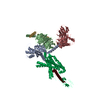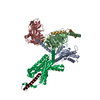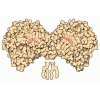[English] 日本語
 Yorodumi
Yorodumi- PDB-7ts0: Cryo-EM structure of corticotropin releasing factor receptor 2 bo... -
+ Open data
Open data
- Basic information
Basic information
| Entry | Database: PDB / ID: 7ts0 | ||||||||||||||||||
|---|---|---|---|---|---|---|---|---|---|---|---|---|---|---|---|---|---|---|---|
| Title | Cryo-EM structure of corticotropin releasing factor receptor 2 bound to Urocortin 1 and coupled with heterotrimeric Go protein | ||||||||||||||||||
 Components Components |
| ||||||||||||||||||
 Keywords Keywords | SIGNALING PROTEIN / GPCR / corticotropin releasing factor receptor 2 / Urocortin 1 / Go protein | ||||||||||||||||||
| Function / homology |  Function and homology information Function and homology informationhistone deacetylase inhibitor activity / corticotrophin-releasing factor receptor activity / corticotropin-releasing hormone receptor 2 binding / positive regulation of corticotropin secretion / positive regulation of behavioral fear response / varicosity / negative regulation of hormone secretion / positive regulation of cAMP-mediated signaling / response to auditory stimulus / drinking behavior ...histone deacetylase inhibitor activity / corticotrophin-releasing factor receptor activity / corticotropin-releasing hormone receptor 2 binding / positive regulation of corticotropin secretion / positive regulation of behavioral fear response / varicosity / negative regulation of hormone secretion / positive regulation of cAMP-mediated signaling / response to auditory stimulus / drinking behavior / negative regulation of appetite / corticotropin-releasing hormone receptor 1 binding / neuropeptide hormone activity / positive regulation of vascular permeability / negative regulation of cell size / G-protein activation / Activation of the phototransduction cascade / Glucagon-type ligand receptors / Thromboxane signalling through TP receptor / Sensory perception of sweet, bitter, and umami (glutamate) taste / G beta:gamma signalling through PI3Kgamma / G beta:gamma signalling through CDC42 / Cooperation of PDCL (PhLP1) and TRiC/CCT in G-protein beta folding / Activation of G protein gated Potassium channels / Inhibition of voltage gated Ca2+ channels via Gbeta/gamma subunits / Ca2+ pathway / G alpha (z) signalling events / Vasopressin regulates renal water homeostasis via Aquaporins / G protein-coupled peptide receptor activity / Glucagon-like Peptide-1 (GLP1) regulates insulin secretion / Adrenaline,noradrenaline inhibits insulin secretion / ADP signalling through P2Y purinoceptor 12 / G alpha (q) signalling events / Class B/2 (Secretin family receptors) / Thrombin signalling through proteinase activated receptors (PARs) / G alpha (i) signalling events / alkylglycerophosphoethanolamine phosphodiesterase activity / photoreceptor outer segment membrane / spectrin binding / negative regulation of feeding behavior / response to pain / positive regulation of calcium ion import / startle response / associative learning / peptide hormone binding / social behavior / photoreceptor outer segment / neuropeptide signaling pathway / positive regulation of collagen biosynthetic process / Synthesis, secretion, and deacylation of Ghrelin / response to glucocorticoid / axon terminus / cardiac muscle cell apoptotic process / regulation of synaptic transmission, glutamatergic / positive regulation of cardiac muscle contraction / negative regulation of blood pressure / photoreceptor inner segment / aerobic respiration / positive regulation of DNA replication / positive regulation of translation / female pregnancy / long-term synaptic potentiation / sensory perception of sound / adenylate cyclase-modulating G protein-coupled receptor signaling pathway / positive regulation of interleukin-6 production / vasodilation / sensory perception of taste / neuron projection development / heterotrimeric G-protein complex / signaling receptor complex adaptor activity / positive regulation of peptidyl-serine phosphorylation / GTPase binding / response to estradiol / retina development in camera-type eye / phospholipase C-activating G protein-coupled receptor signaling pathway / positive regulation of cytosolic calcium ion concentration / cellular response to hypoxia / cell body / G alpha (s) signalling events / positive regulation of cell growth / perikaryon / negative regulation of neuron apoptotic process / response to oxidative stress / cell population proliferation / cell surface receptor signaling pathway / G protein-coupled receptor signaling pathway / negative regulation of gene expression / GTPase activity / dendrite / synapse / protein-containing complex binding / positive regulation of transcription by RNA polymerase II / extracellular region / plasma membrane / cytoplasm Similarity search - Function | ||||||||||||||||||
| Biological species |  Homo sapiens (human) Homo sapiens (human) synthetic construct (others) | ||||||||||||||||||
| Method | ELECTRON MICROSCOPY / single particle reconstruction / cryo EM / Resolution: 2.8 Å | ||||||||||||||||||
 Authors Authors | Zhao, L.-H. / Lin, J. / Mao, C. / Zhou, X.E. / Ji, S. / Shen, D. / Xiao, P. / Melcher, K. / Zhang, Y. / Yu, X. / Xu, H.E. | ||||||||||||||||||
| Funding support |  China, China,  United States, 5items United States, 5items
| ||||||||||||||||||
 Citation Citation |  Journal: Nat Commun / Year: 2022 Journal: Nat Commun / Year: 2022Title: Structure insights into selective coupling of G protein subtypes by a class B G protein-coupled receptor. Authors: Li-Hua Zhao / Jingyu Lin / Su-Yu Ji / X Edward Zhou / Chunyou Mao / Dan-Dan Shen / Xinheng He / Peng Xiao / Jinpeng Sun / Karsten Melcher / Yan Zhang / Xiao Yu / H Eric Xu /   Abstract: The ability to couple with multiple G protein subtypes, such as G, G, or G, by a given G protein-coupled receptor (GPCR) is critical for many physiological processes. Over the past few years, the ...The ability to couple with multiple G protein subtypes, such as G, G, or G, by a given G protein-coupled receptor (GPCR) is critical for many physiological processes. Over the past few years, the cryo-EM structures for all 15 members of the medically important class B GPCRs, all in complex with G protein, have been determined. However, no structure of class B GPCRs with G has been solved to date, limiting our understanding of the precise mechanisms of G protein coupling selectivity. Here we report the structures of corticotropin releasing factor receptor 2 (CRF2R) bound to Urocortin 1 (UCN1), coupled with different classes of heterotrimeric G proteins, G and G. We compare these structures with the structure of CRF2R in complex with G to uncover the structural differences that determine the selective coupling of G protein subtypes by CRF2R. These results provide important insights into the structural basis for the ability of CRF2R to couple with multiple G protein subtypes. | ||||||||||||||||||
| History |
|
- Structure visualization
Structure visualization
| Structure viewer | Molecule:  Molmil Molmil Jmol/JSmol Jmol/JSmol |
|---|
- Downloads & links
Downloads & links
- Download
Download
| PDBx/mmCIF format |  7ts0.cif.gz 7ts0.cif.gz | 250.3 KB | Display |  PDBx/mmCIF format PDBx/mmCIF format |
|---|---|---|---|---|
| PDB format |  pdb7ts0.ent.gz pdb7ts0.ent.gz | 195 KB | Display |  PDB format PDB format |
| PDBx/mmJSON format |  7ts0.json.gz 7ts0.json.gz | Tree view |  PDBx/mmJSON format PDBx/mmJSON format | |
| Others |  Other downloads Other downloads |
-Validation report
| Arichive directory |  https://data.pdbj.org/pub/pdb/validation_reports/ts/7ts0 https://data.pdbj.org/pub/pdb/validation_reports/ts/7ts0 ftp://data.pdbj.org/pub/pdb/validation_reports/ts/7ts0 ftp://data.pdbj.org/pub/pdb/validation_reports/ts/7ts0 | HTTPS FTP |
|---|
-Related structure data
| Related structure data |  26104MC  7tryC M: map data used to model this data C: citing same article ( |
|---|---|
| Similar structure data | Similarity search - Function & homology  F&H Search F&H Search |
- Links
Links
- Assembly
Assembly
| Deposited unit | 
|
|---|---|
| 1 |
|
- Components
Components
-Protein , 4 types, 4 molecules PABG
| #1: Protein | Mass: 63716.246 Da / Num. of mol.: 1 Source method: isolated from a genetically manipulated source Source: (gene. exp.)  Homo sapiens (human) / Gene: CRHR2, CRF2R, CRH2R / Production host: Homo sapiens (human) / Gene: CRHR2, CRF2R, CRH2R / Production host:  |
|---|---|
| #3: Protein | Mass: 40032.488 Da / Num. of mol.: 1 Source method: isolated from a genetically manipulated source Source: (gene. exp.)  Homo sapiens (human) / Production host: Homo sapiens (human) / Production host:  |
| #4: Protein | Mass: 43706.750 Da / Num. of mol.: 1 Source method: isolated from a genetically manipulated source Source: (gene. exp.)   |
| #5: Protein | Mass: 7861.143 Da / Num. of mol.: 1 Source method: isolated from a genetically manipulated source Source: (gene. exp.)   |
-Protein/peptide / Antibody , 2 types, 2 molecules UH
| #2: Protein/peptide | Mass: 4703.277 Da / Num. of mol.: 1 / Fragment: UNP residues 83-122 / Source method: obtained synthetically / Source: (synth.)  Homo sapiens (human) / References: UniProt: P55089 Homo sapiens (human) / References: UniProt: P55089 |
|---|---|
| #6: Antibody | Mass: 26277.299 Da / Num. of mol.: 1 Source method: isolated from a genetically manipulated source Source: (gene. exp.) synthetic construct (others) / Production host:  |
-Details
| Has ligand of interest | N |
|---|
-Experimental details
-Experiment
| Experiment | Method: ELECTRON MICROSCOPY |
|---|---|
| EM experiment | Aggregation state: PARTICLE / 3D reconstruction method: single particle reconstruction |
- Sample preparation
Sample preparation
| Component | Name: Corticotropin releasing factor receptor 2 (CRF2R) bound to Urocortin 1 (UCN1) and coupled with G11 proteins Type: COMPLEX / Entity ID: all / Source: MULTIPLE SOURCES |
|---|---|
| Source (natural) | Organism:  Homo sapiens (human) Homo sapiens (human) |
| Source (recombinant) | Organism:  |
| Buffer solution | pH: 7.5 |
| Specimen | Embedding applied: NO / Shadowing applied: NO / Staining applied: NO / Vitrification applied: YES |
| Vitrification | Cryogen name: ETHANE |
- Electron microscopy imaging
Electron microscopy imaging
| Experimental equipment |  Model: Titan Krios / Image courtesy: FEI Company |
|---|---|
| Microscopy | Model: FEI TITAN KRIOS |
| Electron gun | Electron source:  FIELD EMISSION GUN / Accelerating voltage: 300 kV / Illumination mode: FLOOD BEAM FIELD EMISSION GUN / Accelerating voltage: 300 kV / Illumination mode: FLOOD BEAM |
| Electron lens | Mode: BRIGHT FIELD / Nominal defocus max: 4000 nm / Nominal defocus min: 1000 nm |
| Image recording | Electron dose: 64 e/Å2 / Film or detector model: GATAN K2 SUMMIT (4k x 4k) |
- Processing
Processing
| Software | Name: PHENIX / Version: 1.13_2998: / Classification: refinement | ||||||||||||||||||||||||
|---|---|---|---|---|---|---|---|---|---|---|---|---|---|---|---|---|---|---|---|---|---|---|---|---|---|
| CTF correction | Type: PHASE FLIPPING AND AMPLITUDE CORRECTION | ||||||||||||||||||||||||
| 3D reconstruction | Resolution: 2.8 Å / Resolution method: FSC 0.143 CUT-OFF / Num. of particles: 171435 / Symmetry type: POINT | ||||||||||||||||||||||||
| Refine LS restraints |
|
 Movie
Movie Controller
Controller



 PDBj
PDBj
















